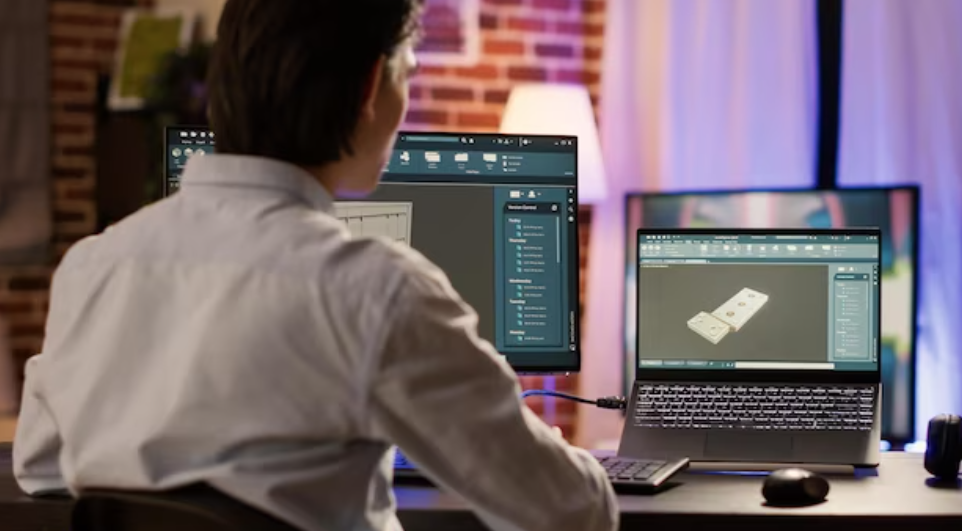Have you ever looked at a fancy car or a tall building and thought, “How did they make that?” Well, Computer-Aided Design programs are the secret behind it all. It’s like a super tool that helps people design things with fantastic precision using computers. CAD isn’t just any tool; it’s what turns big ideas into real-life creations. Let’s dive into the world of CAD together, where we’ll discover how it works and why it’s such a big deal in shaping our world.
What is CAD software?
CAD involves utilizing computer software and hardware to generate, alter, scrutinize, and refine designs. These designs can span diverse products, structures, and systems. CAD software empowers designers and engineers to translate their concepts into digital models with accuracy and effectiveness.
What is its purpose?
CAD revolutionizes the way designers and engineers conceptualize, refine, and bring their ideas to life in the digital realm.
Time Efficiency: CAD software accelerates design processes, enabling quicker production of high-quality designs.
Simplified Editing: It facilitates easy modifications, allowing for swift error correction and drawing alterations.
Reduced Error Rates: Its tools utilize advanced features that markedly diminish the occurrence of errors compared to manual methods.
Effort Reduction: CAD automation streamlines design tasks, minimizing the overall effort required for creating various models.
Code Reusability: CAD permits the reuse of design components, reducing redundant work and optimizing resource utilization.
Seamless Sharing: CAD files can be effortlessly saved, stored, and shared, enhancing collaboration and communication among team members.
Enhanced Precision: Computer-aided design programs deliver unmatched precision and accuracy, surpassing the capabilities of manual drawings, enabling designers to ensure the highest level of accuracy in their designs.
Applications of CAD
CAD is incredibly versatile due to its capabilities in numerical data modeling, simulation, and design. Here are some key areas where CAD finds significant application:

3D Printing:
CAD plays a crucial role in creating digital models for 3D Printing. This additive manufacturing process builds objects layer by layer using materials like thermoplastics. CAD files generated from 3D modeling programs or reverse engineering form the basis for these objects. Industries widely use Computer-aided design programs for tasks ranging from preparing drawings for 3D Printing to developing prototypes.
Dental Industry:
CAD technology revolutionizes the design and production of dental elements, offering precise 3D representations of oral structures for restorative procedures. It enables the creation of custom parts such as veneers and crowns without the need for physical molds, saving time and enhancing patient comfort.
Mapping:
While digital maps are prevalent, CAD allows for the creation of custom maps with personalized points of interest, routes, and accommodations. These digital maps can be stored on devices or printed, offering navigation assistance even in areas with limited cellular coverage.
Fashion:
Computer-aided design programs support fashion designers in conceptualizing designs and streamlining various processes, including pattern creation, virtual fitting, and marker creation. It accelerates production timelines, enables virtual visualization of designs, and minimizes the need for physical prototypes.
Architecture:
CAD aids architects in producing technical drawings, 2D or 3D representations, and animations for architectural projects. These technical drawings provide detailed instructions for construction, including floor plans and scaled diagrams.
Furniture Design:
CAD facilitates the creation of intricate furniture designs, offering specialized tools tailored to the furniture industry’s needs. It enables rapid prototyping, customization, and efficient production processes to meet market demands.
Automotive Sector:
CAD is extensively utilized in the automotive industry for design, simulation, and manufacturing processes. It enhances efficiency, shortens development cycles, and fosters collaboration among global suppliers, ultimately improving product quality.
Interior Design:
CAD simplifies the creation of room layouts and mockups, transitioning from 2D floor plans to 3D models. Features like RoomMaker in software such as AutoCAD enable designers to visualize and present designs effectively to clients.
Types of CAD
CAD offers a spectrum of tools tailored to diverse design needs and creative expressions.
2D CAD:
Description: Involves creating flat, two-dimensional drawings comprising lines, circles, and curves.
Common Usage: Typically used for architectural blueprints or engineering layouts.
3D CAD:
Description: More advanced, involves creating solid objects in a three-dimensional space.
Common Usage: Allows engineers and architects to visualize and manipulate designs from various angles, providing a better understanding of the final product’s appearance and functionality.
Freeform CAD:
Description: Enables the design of complex and unconventional shapes not feasible with traditional CAD tools.
Common Usage: Widely utilized in the fashion and entertainment industries for tasks such as clothing design and CGI character creation.
Future trends in CAD
Looking ahead, computer-aided design programs are set to undergo exciting advancements. Here are some rising trends that will shape the future of CAD:
Cloud-Based CAD: Like many other software tools, CAD is transitioning to the cloud. This shift offers improved collaboration, remote access to designs, and cost savings by eliminating the need for expensive hardware and constant software upgrades.
Artificial Intelligence and Machine Learning: Both are expected to revolutionize CAD by automating routine design tasks, recognizing design patterns, and suggesting enhancements. This will streamline the design process, making it more efficient and intelligent.
Virtual Reality and Augmented Reality: For immersive design experiences, these technologies will help. It enables designers to visualize and interact with 3D models in realistic environments. They will also enhance client presentations by offering more engaging and understandable design demonstrations.
Generative Design: This innovative approach involves inputting design goals and constraints into CAD software, which then utilizes algorithms to generate optimal design options. It allows for rapid exploration of various design possibilities, often leading to innovative solutions beyond human imagination.
Conclusion
CAD is essential in product engineering and industry because it lets engineers create, test, and improve designs without spending a lot on prototypes. With computer-aided design programs, they can also keep detailed records and collaborate easily with different teams involved in making the product. That’s why it’s crucial for organizations to understand how CAD works and its main ideas to stay ahead in their fields. To keep your pace up in designing, you can get help from ALCADS, which provides an effective CAD solution.

